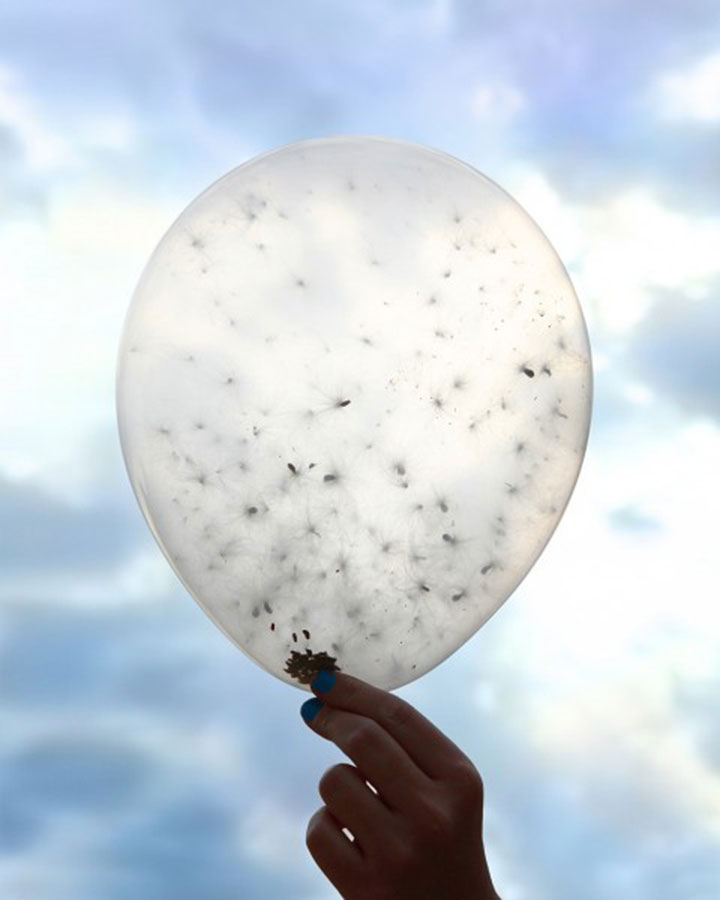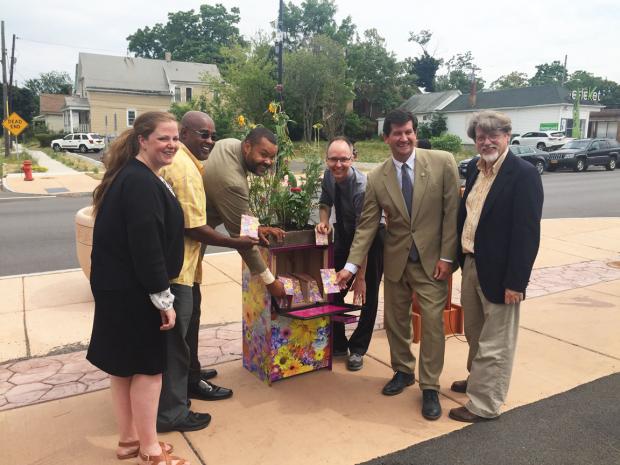The Albright-Knox Plants a Seed
The public art initiative that brought Shark Girl and the Silent Poets to Canalside and the “You Are Beautiful” billboards across local highways is focusing its efforts on a project that seeks to promulgate wildflowers that sustain the pollinators that forage our region. Rewilding New York, a project by Chicago artist Jenny Kendler, has placed repurposed Buffalo News newspaper boxes throughout the county, wrapped them in Kendler’s wildflower designs (see this issue’s cover), and filled them with seed packets of indigenous wildflowers—species that offer nectar-rich snacks to the bees and butterflies that live in and traverse the area.
Albright-Knox Art Gallery public art curator Aaron Ott was on hand at Monday’s press conference outside Mattie’s Restaurant on Fillmore Avenue along with Erie County Executive Mark Poloncarz and others to announce the latest installment of the partnership between the county, the city, and the Albright-Knox. Ott was familiar with Kendler’s work from his own time in Chicago. “I was drawn to the activism of [Kendler’s earlier] work but challenged Kendler to think about a method of interaction that would be more direct and not necessitate technologies that might not be readily available in the communities that we hoped to impact,” Ott explained in an email.
The boxes can be found throughout the county, from Clarence to Orchard Park; Ott and Poloncarz advocated for three of the boxes to be placed on the city’s East Side. Ott characterized the beleagured neighborhood as “chronically underserved” and Poloncarz told The Public, “It’s important to understand art comes in so many forms and to actually bring it out to the community is something I want to do. Especially here on the East Side of Buffalo where a child may never walk into a gallery—now they can access art right in their own neighborhood.”
Rita Gay of the Fillmore Corridor Neighborhood Coalition stated she was “delighted” to have such interest in her neighborhood for the project. “To have an organization like the Albright-Knox do this is a step in the right direction for us.”
The 10 boxes each contain about 1,000 envelopes filled with a seed mixture of wildflowers chosen for their heartiness, adaptability, and nectar content: White Yarrow, Anise Hyssop, Red Milkweed, Common Milkweed, Lance Leaf Coreopsis, Purple Coneflower, Ox-eye Sunflower, Bergamot. Stiff Goldenrod, Black-eyed Susan, and New England Aster. The back of each envelope is a postcard addressed to Governor Andrew Cuomo in support stronger pesticide regulation to stem the steep decline of butterfly and bee populations.

Milkweed Dispersal Balloons, by Jenny Kendler. Image courtesy the artist/Albright-Knox.
Reached by phone, artist Jenny Kendler was buzzing about the images she had already seen from the Buffalo press conference announcing Rewilding New York:
Can you explain the general concept of “rewilding”? The concept of rewilding means looking at the world around us and thinking of how we can bring it back to a more verdant, more biodiverse state. To me in particular, it means that humans are part of the world; and, while were not trying to bring back some archaic version of nature 500 years in the past, we need to remember we live in a sustained ecosystem. The exciting thing is that it starts with the plants, and that’s actually really easy. It’ll be hard to get apex predators reintroduced throughout the United States, for example, but we can start small and get people to plant native plants.
Tell me about pollinators and your vision for these boxes. Generally, what makes this art and not strictly wildlife conservation? I’m the artist-in-residence for the Natural Resources Defense Council—an international environmental nonprofit—and I actually approached them white a while back, because I was really interested in finding the place between art and activism. It’s been a lifelong goal of a mine to try to find a way to work in the two spaces, and the residency with NRDC has been really fruitful for that reason. In this case, they were instrumental in crafting one of the more direct activist components of this project, which is the postcards we’re asking people to send in to Governor Cuomo’s office—which will protect not just pollinators but also human health. I’m trying to find way for people to reengage with the natural world and this concept of rewilding is really interesting to me.
In your background research on pollinators and wildflowers, did you encounter any information, facts, details, etc. that you’ve grasped on to conceptually as you’ve developed this project? Researching plant and pollinators is part of my natural process, other than being an artist I’m actually a really big nature nerd. I like to know the names of all the plants and I like to know the Latin names, so it was an interesting experience for me. I’ve been working with native plants in the Midwest and in Louisville, Kentucky, so it’s been this interesting mapping process to see which species overlap between the different areas, while also looking at pollinators. Something like one in three bites of food that you eat is pollinated by bees. Realizing that bees are under such amazing threat is definitely something I want to make people more aware of. And the monarchs have been a focus of mine for a long time. Buffalo happens to be right on the eastern edge of the monarch migration, so we worked in two species of milkweed as milkweed is the only plant that monarchs can lay their eggs on, and the only plants their caterpillars can eat. If a butterfly can’t find a plant to lay an egg then that generation dies off—and their populations have been reduced about 90 percent. It’s very conceivable, sadly, within our lifetime that this magnificent 3,000-mile migration that these tiny fragile butterflies make could be lost from the planet. So, that’s one of the key issues we’re focusing on and again part of our ask to Governor Cuomo’s office.
There are literally millions of seeds inside of these packets, it’s astonishing to think of how many plants can grow from that.
For a full list of Rewilding New York boxes, visit the Albright-Knox’s website.

